Matthew Fontaine Maury Monument
Introduction
Text-to-speech Audio
Images
Maury Monument (source: Phil Riggan, Richmond on the James)

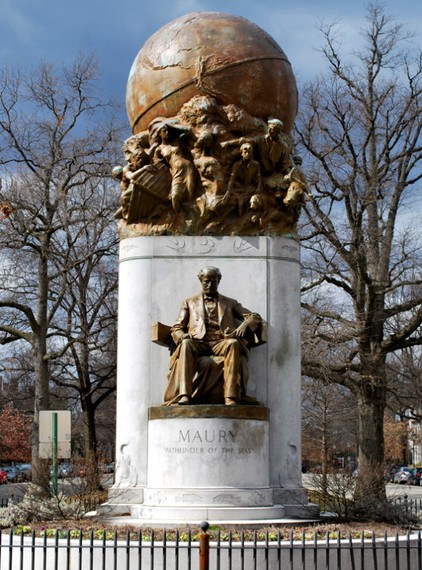
Maury statue (left) and Elvira Moffitt (right) (image from WTVR News)
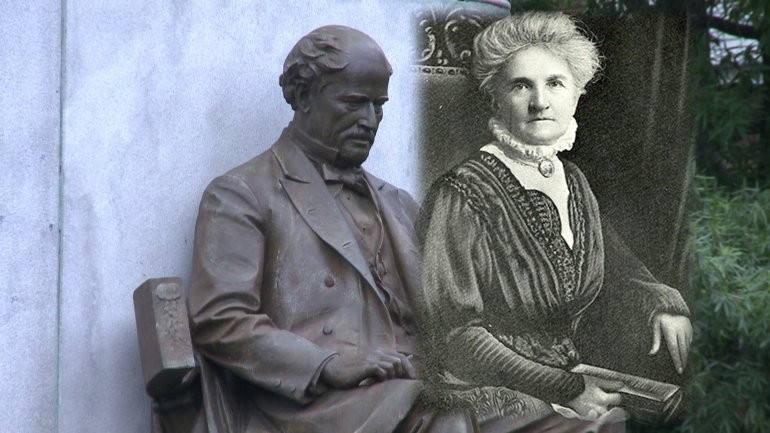
Matthew Fontaine Maury
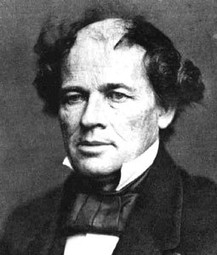
Statue of Maury on the Monument Avenue monument
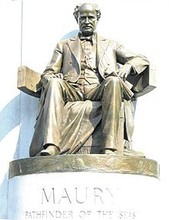
Maury's wind and current chart of the Gulf Stream, circa 1852
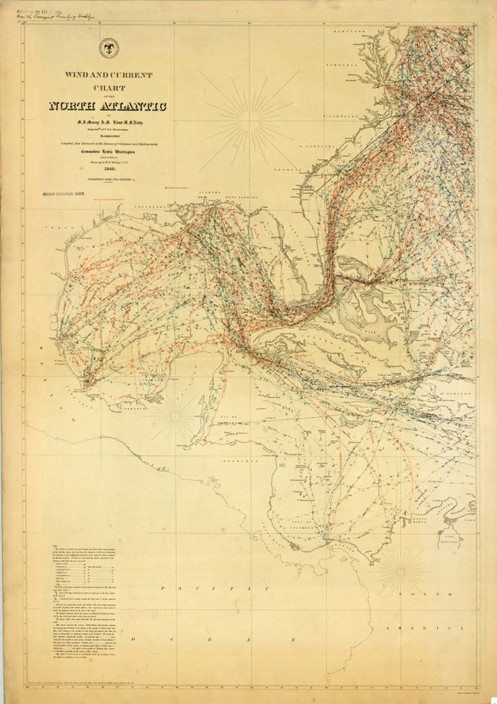
Maury's map of the known world, circa 1847.
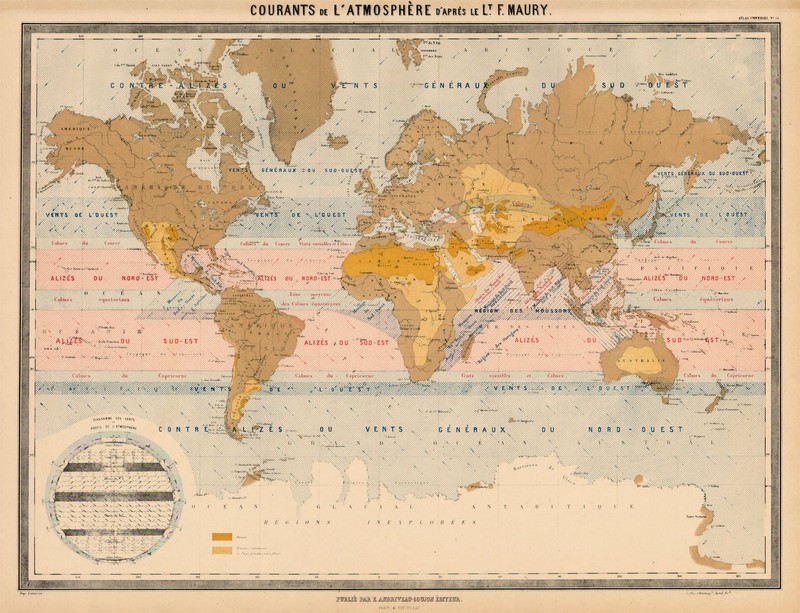
The Maury statue is removed to a truck, July 2, 2020
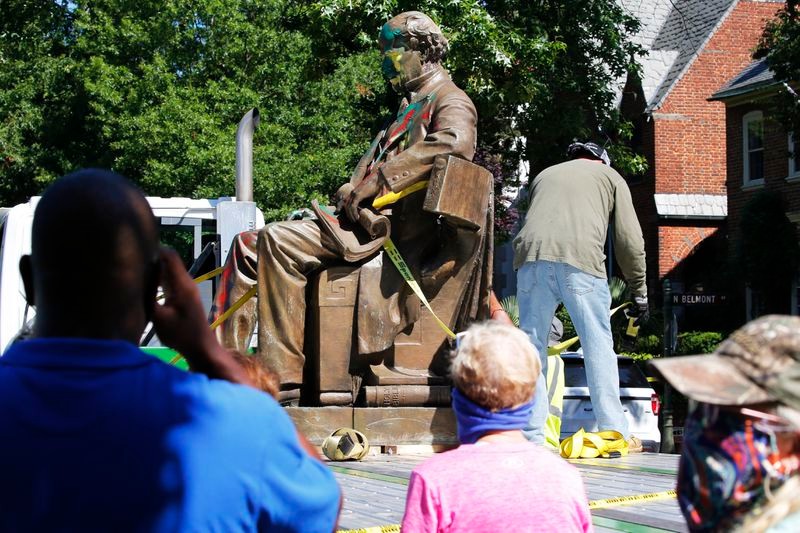
Backstory and Context
Text-to-speech Audio
Matthew Fontaine Maury was born in Spotsylvania County, Virginia on January 14, 1806. At five years old, his family moved to Franklin, Tennessee where Maury attended the Harpeth Academy and studied under Gideon Blackburn and James Otey, Tennessee’s first Episcopal Bishop. In 1825, the nineteen-year-old Maury joined the U.S. Navy as a midshipman aboard the USS Brandywine, notable for carrying the famed Marquis de Lafayette back to France. During the next fourteen years in the navy, Maury scientifically studied the oceans and navigation methods. From his studies came two books, the first in 1830 called Navigation after a Voyage around the World and the second in 1836 titled A New Theoretical and Practical Treatise on Navigation. Several of those fourteen years were spent on the ocean, he was aboard the USS Vincennes when it became the first US warship to circumnavigate the world.
Maury suffered a broken leg during a stagecoach accident in 1839 and became unfit for duty at sea at age 33. Undeterred, the sailor devoted himself to the full-time study of oceanography, meteorology, and navigation, producing several well-received publications. Because of his research, Maury received an appointment as the superintendent of the Navy’s Depot of Charts and Instruments in 1842, renamed the United States Naval Observatory two years later. Maury’s primary duties involved caring for navigational equipment, which included thousands of unread ships’ logs. The sheer amount of information available to Maury allowed him to generate more accurate and safer navigational charts, producing his seminal works of Wind and Current Charts of the North Atlantic in 1847, Explanations and Sailing Directions to Accompany the Wind and Current Charts in 1851, and The Physical Geography of the Sea in 1855. In 1853, he organized the International Maritime Meteorological Conference in Brussels, during which he was awarded medals from the participating countries for his efforts to make ocean travel safer. Maury’s research helped pave the way for a scientific and mathematical understanding of oceanography, meteorology, and maritime navigation.
The outbreak of the Civil War put Maury in a difficult position. He did not personally own slaves, nor did he wholly support the institute of slavery, but like many Americans he held sharp white supremacist views. He believed that slavery could be slowly eliminated in the United States by simply relocating the slaves to the Amazon as a means to "revolutionize and republicanize and Anglo-Saxonize that valley" (quoted in Grady, p. 137). Moreover, he viewed the Amazon as a potential "safety valve" for the large slave population in the United States. He asked, "What is to become of [slavery]? If it is abolished, how are so many people to be got rid of? If retained, how are they to be controlled?" Brazil and the Amazon provided a solution: "The valley of the Amazon is the way; in this view, it is the safety-valve of the Union. It is a slave territory and a wilderness. One among the many results of this line of steamers is the entire suppression of the African slave trade with Brazil by a substitution therefore of a slave emigration from the United States" (quoted in Johnson, p. 301). In essence, Maury promoted the establishment of a slave-holding American colony in South America.
Maury considered himself first and foremost a Virginian and refused to fight against his home state, so in 1861 Maury withdrew from the United States Navy to become a commander for the Confederate Navy. During the war, he traveled to England to represent Southern interests there, obtained war vessels for the South, and strengthened the Confederacy's harbor defenses. He is well-known for working on electric mines, which were used successfully against Union ships. Maury was still in England when the war ended in 1865 and went into exile in Mexico. There, he assisted Emperor Maximillian I establish a colony of exiled Virginians, hoping to create a New Virginia where the slaveholding, plantation society of the South could reestablish itself. Fleeing Mexico during the overthrow of Maximillian in 1867, he sought refuge back in England, and returned to the United States a year later to teach meteorology at the Virginia Military Institute. Matthew Fontaine Maury died on February 1, 1873 in his home in Lexington, Virginia. After his death, Maury faded into relative obscurity.
Unlike many Confederate monuments, the proposal for Maury's statue was inspired not by his military career, but by his scientific contributions. When Richmond writer and businessman Gaston Liechtenstein visited Germany in 1906 he found that Maury, known as the Pathfinder of the Seas and the Father of Modern Oceanography, was a highly regarded individual and praised for his invaluable contributions to science. When he returned to Richmond, Liechtenstein began campaigning for a monument to honor Maury. Hearing of Liechtenstein’s monument proposal, Elvira Worth Moffitt, daughter of former North Carolina Governor Jonathan Moffit, took up the cause and created the Matthew Fontaine Maury Monument Association in May 1915. Five years later, the Virginia General Assembly donated the first $10,000 of the required $50,000 for the project. In 1921, the Association selected local sculptor Frederick William Sievers to design the monument, and in 1922, a site was selected on Monument Avenue.
Unveiled on November 11, 1929, Sievers’ Matthew Fontaine Maury Monument resembled nothing like the four other Confederate monuments along the avenue. With Maury, holding a sea chart in one hand, seated in front of a globe “listening to the voice of the winds and the voice of the waves…in profound thought,” Sievers described his design as “an allegory of the sphere of Maury’s mind, which was nothing less than the entire universe.” Eager to step away from the Lost Cause iconography of the previous four decades, Sievers took advantage of Maury’s unique accomplishments and created a monument that focused on his successes rather than his political allegiance. The sculptor wrote in 1922 when proposing his design, “The conception at first glance may seem a bit revolutionary — it is not — neither is it my endeavor to attempt anything vague or extreme… It is, however, my direct intention to depart from the stereotyped use of allegorical figures borrowed from a defunct religion to symbolize the greatness of an individual of a widely different era.” The fact that the Maury Monument met very little resistance and was unveiled on Armistice Day, instead of a Confederate holiday, suggests that Richmond was beginning to move out of the Lost Cause and into the modern era.
Although the Maury Monument burnishes his scientific contributions, his Confederate service and placement with other Confederate statues along Monument Avenue has led to calls for its reinterpretation or removal in recent years, especially in the wake of the 2017 Unite the Right rally and violence in Charlottesville. In 2020, these calls grew in the wake of the death of George Floyd and nationwide protests over systemic racism. In March 2020, the Virginia General Assembly passed legislation allowing for local communities to remove Confederate statues. In July, Richmond Mayor Levar Stoney ordered the Confederate statues along Monument Avenue removed. On July 2, 2020, the Maury Monument was loaded on a truck and taken into storage. With the exception of the Robert E. Lee Monument (under litigation), the other Confederate monuments along Monument Avenue have likewise been removed.
Sources
1. Grady, John. Matthew Fontaine Maury, Father of Oceanography: A Biography, 1806-1873. Jefferson, NC: McFarland & Co., 2015.
2. Hecht, Susanna. The Scramble for the Amazon and the "Lost Paradise" of Euclides da Cunha. Chicago. University of Chicago Press, 2013. Esp. p. 142-144.
3. Holmberg, Mark. "Yes, let's have a good look at RVA's monumental history." WTVR News. June 23, 2017. Accessed September 6, 2017. http://wtvr.com/2017/06/23/Confederate-tributes-narrative-is-complicated-tapestry/.
4. Johnson, Walter. River of Dark Dreams: Slavery and Empire in the Cotton Kingdom. Cambridge, MA: Harvard University Press, 2013.
5. Kollatz, Harry, Jr. "Maury and His Maker." Richmond Magazine. March 24, 2010. Accessed September 6, 2017. http://richmondmagazine.com/news/maury-and-his-maker-03-24-2010.
6. Monument Avenue Historic District. National Park Service. Accessed February 21, 2017. https://www.nps.gov/nr/travel/richmond/monumentavehd.html.
7. Powell, William S., ed. "E.E. Moffitt." Dictionary of North Carolina Biography. 1979-1996. University of North Carolina Press. Accessed September 8, 2017 at http://docsouth.unc.edu/nc/moffitt/bio.html.
8. St. Onge, Tim. Scientist of the Seas: The Legacy of Matthew Fontaine Maury. Library of Congress Blogs. July 25, 2018. June 21, 2019. https://blogs.loc.gov/maps/2018/07/scientist-of-the-seas-the-legacy-of-matthew-fontaine-maury/.
9. Matthew Fontaine Maury. National Park Service. June 17, 2015. June 21, 2019. https://www.nps.gov/people/matthew-fontaine-maury.htm.
10. Goodsell, Leo J. Matthew Fontaine Maury. Tennessee Encyclopedia. March 1, 2018. June 21, 2019. https://tennesseeencyclopedia.net/entries/matthew-fontaine-maury/.
11. On Monument Avenue | A Confederate for the World. The American Civil War Museum. June 21, 2019. https://acwm.org/blog/monument-avenue-Confederate-world.
12. Brumfield, Dale M. Dale M. Brumfield: Why we should save the Maury monument. Richmond-Times Dispatch. November 10, 2017. June 21, 2019. https://www.richmond.com/opinion/their-opinion/guest-columnists/dale-m-brumfield-why-we-should-save-the-maury-monument/article_b2ba4548-d5fb-5bd1-a4ce-0698a9372109.html.
13. 127-0174 Monument Avenue Historic District. Virginia Department of Historic Resources. April 1, 2019. June 21, 2019. https://www.dhr.virginia.gov/historic-registers/127-0174/.
14. Moody, Jr., James W. National Register of Historic Places Inventory - Nomination Form. Virginia Department of Historic Resources. February 26, 1970. June 21, 2019. https://www.dhr.virginia.gov/wp-content/uploads/2018/04/127-0174_Monument_Avenue_HD_1969_Nomination_final.pdf.
15. "Richmond removes statue of Confederate Matthew Maury, namesake for Naval Academy." July 6, 2020. Capital Gazette. Web. Accessed November 10, 2020. https://www.capitalgazette.com/news/nation-world/bc-us-racial-justice-confederate-statues-virginia-20200706-ycfylr3llran5bhxqyyh7s3txm-story.html
Steve Helber/AP, Capital Gazette: https://www.capitalgazette.com/news/nation-world/bc-us-racial-justice-confederate-statues-virginia-20200706-ycfylr3llran5bhxqyyh7s3txm-story.html
